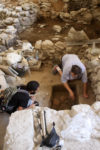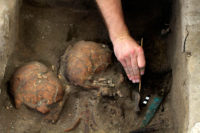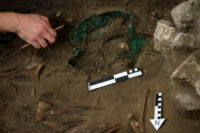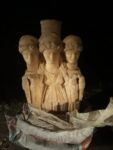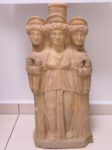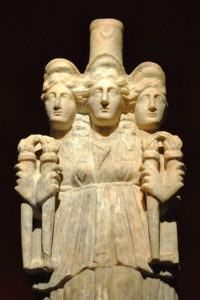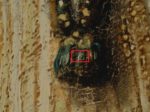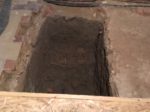 Archaeologists believe they have discovered the grave of Peter I Orseolo, the second king of Hungary, in the crypt of the Cathedral of St. Peter and St. Paul in Pécs, southwest Hungary. No remains were found in the tomb, likely because they were deliberately moved centuries later.
Archaeologists believe they have discovered the grave of Peter I Orseolo, the second king of Hungary, in the crypt of the Cathedral of St. Peter and St. Paul in Pécs, southwest Hungary. No remains were found in the tomb, likely because they were deliberately moved centuries later.
The team of archaeologists from the Janus Pannonius Museum were hoping to determine the location of the first cathedral built at the site in the 11th century. They discovered a wall under the crypt that was part of the original structure. The empty grave was found near it. As only the founders of churches were buried in the crypt in 11th century Hungary, the location suggests it was the burial of one of the founders.
The remains were carefully exhumed, not disturbed by later construction of haphazardly ditched. That indicates the remains belonged to someone of note, that they were removed with care for transfer to a new location. There are only two viable candidates: King Peter or Blessed Maurus, the second Bishop of Pécs. Maurus, however, died around 1075, after the construction of the current church, so the grave is almost certainly Peter’s.
The Orseolos were an illustrious Venetian noble family descended from Orso Ipato, dux of Venice, ie, leader of the Byzantine Empire’s military forces in territories under its rule. But while Venice was technically part of the Byzantine Exarchate of Ravenna, it chafed at Byzantine control during this period of iconoclastic conflict between empire and papacy. In a big middle finger to the emperor, Venice elected its first independent Doge, the Venetian dialect’s word for dux, in 726: Orso Ipato. He was a great military leader who built Venice’s navy into a formidable force and helped kick the Lombards of King Liutprand out of Ravenna in 737 which eased tensions with the empire for a bit. (The Lombards would retake Ravenna in 751 and end Byzantine rule for good).
The next doge was Orso’s son Teodato. Another three Orseolos would take the office in the late 10th and early 11th century (five if you count Giovanni who co-ruled with his father Pietro II and Domenico who ruled for one day in 1031). The family was powerful militarily, wealthy and enormously influential, so much so that other Venetian families sought to bring them down and successfully did so. After the last real doge of the family, Ottone Orseolo, was exiled in 1026, its dominance of city politics was over.
By then the Orseolos had established very elevated connections indeed, ones that reached far beyond the boundaries of the lagoon. Ottone was named after his godfather, Holy Roman Emperor Otto III, and he married the sister of the Stephen I, first king of Hungary. When Stephen died in 1038, Ottone’s son Pietro succeeded his uncle as King of Hungary.
It would not be a placid transition. Stephen’s cousin Vazul had the stronger claim to the throne, but Stephen was not a fan and had him blinded and his sons exiled to smooth Pietro’s succession. Stephen, btw, would be canonized a saint less than 50 years after his death by Pope Gregory VII. Then, once Pietro was on the throne, he infuriated Hungary’s aristocracy by favoring Germans and Italians, both at court and in military alliances. He was also reputed to be a sexual predator who raped Hungarian noblewomen wherever he went.
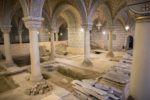 Pietro was overthrown by Hungary’s lords in 1041. He did get his crown back, but he had to bend the knee to Holy Roman Emperor Henry III to get it. Henry invaded Hungary and slaughtered it back for Pietro. This second rule would be even shorter than the first, lasting from 1044 until 1046. This time it was a popular uprising by Hungarian non-Christians that overthrew him. Karma struck and he was blinded by supporters of Vazul’s son Andrew. Sources differ on when he died, then or a decade later, but whenever it happened, he was buried in St. Peter and St. Paul’s Cathedral, the church he had had built on the site of a late Roman cemetery. Pietro’s original cathedral burned down in 1064. The one that stands today was built over its remains.
Pietro was overthrown by Hungary’s lords in 1041. He did get his crown back, but he had to bend the knee to Holy Roman Emperor Henry III to get it. Henry invaded Hungary and slaughtered it back for Pietro. This second rule would be even shorter than the first, lasting from 1044 until 1046. This time it was a popular uprising by Hungarian non-Christians that overthrew him. Karma struck and he was blinded by supporters of Vazul’s son Andrew. Sources differ on when he died, then or a decade later, but whenever it happened, he was buried in St. Peter and St. Paul’s Cathedral, the church he had had built on the site of a late Roman cemetery. Pietro’s original cathedral burned down in 1064. The one that stands today was built over its remains.
The archaeological excavation of the crypt unearthed remains of the late 4th century Roman cemetery. They suggest Christian practices had reached this area of Hungary much earlier than previously realized.
The Diocese plans to make the archaeological remains a permanent part of the church instead of reburying them. That way visitors to the crypt will be able to see its ancient and medieval antecedents.
